Entries tagged with “industrial hygiene”.
Did you find what you wanted?
Thu 4 Dec 2014
Posted by admin under Air Monitoring, Asbestos, Building Survey, Carbon Monoxide, Concrete, Dust, IAQ, industrial hygienist, occupational hygiene, Presentation, Silica, Training, Uncategorized
Comments Off on All I want for my (IH) Christmas…
Here’s my top 5 gifts for Christmas in the (my) occupational hygiene world of construction:
- A new carbon monoxide monitor.
- Not just a “normal” $40 model. A Nest Protect Fire & Carbon Monoxide monitor, which is in the $100 range. This thing is sweet. Talks to you, sends you a text message. Here’s a review from Cool Tools. Or, just buy it here.
- High flow air pump, Gast model.
- I have some other flow rate pumps up to 5 liters per minute (LPM), but this one is great for flow rates 10-up to 28 LPM (depending on the model). Good for high volume area type samples and vacuum wipe sampling. You must have 110 power available, but once calibrated, it’s a done-deal. They can be bought for under $250. Grab a rotometer too, if you don’t have one.
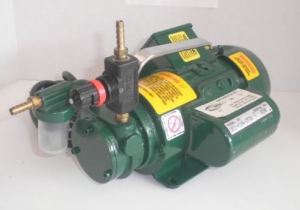
- Wireless response system to use during training.
- Attendees have a wireless response keypad and the trainer can ask a multiple choice question. It allows the audience to reply. The results then show up on the screen. Great for anonymous responses, or a general overview from your audience. There are several vendors, here’s an example, and the leader in the industry is Turning Point. I think these are in the $500-$1,000 range.
- A bulk asbestos example kit.
- A bunch of “typical” building materials which are asbestos containing. In sealed glass jars, of course. I don’t know where you’d buy this sort of thing. I wish I would have kept all of my samples over the years.
- A dedicated short term silica sampling kit.
- SKC has a new sampler which can sample at a higher flow rate  of 8 LPM, compared with the usual 2.5, or 1.8 LPM. (which, if you think through the math; allows you to achieve a detection limit with a lower sample volume, and a shorter time duration) Unfortunately, you must purchase a new SKC Leland pump/charger, PPI sampler, calibration junk. Total cost is probably in the $2,000 range.
Fri 6 Sep 2013
Posted by admin under Asbestos, Building Survey, Cadmium, Carcinogen, Exposure, Lead, Management, OSHA, Uncategorized
Comments Off on Let me give you a “hypothetical” worst-case scenario:
Hypothetically (and allegedly):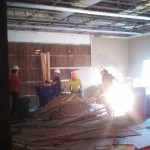
- You receive a project as a subcontractor.
- You are verbally told no asbestos or lead onsite. Only that’s not true.
- There is asbestos, and you, and multiple other subs, have disturbed it.
- The prime contractor says, “oops”. Has the materials tested, and then blames the owner for not letting them know.
- OSHA is called and citations are issued to the owner and GC for not testing and telling people.
- A year goes by and now both the owner and GC are being sued by 5 employees for $10,000,000 (yep $10 million, that’s the max BTW).
- As a footnote: this incidentally is not a worker compensation case (yet) since they are not suing their employer (they are suing the GC and owner)
Even if the employees don’t win $10m, are you prepared for: the headache, loss of client-relationship, trust breaking? Here’s a similar hypothetical article about such a situation.
On the flip side, here are some positive things you can do:
- get a written copy of the building survey (lead & asbestos) ALWAYS. (you might also ask for cadmium, radon, other possible hazardous substances)
- Train your employees about asbestos prior to having to deal with it.
- Give employees the power to “stop work” if they are suspicious of possible asbestos containing material (PACM).
- When handing out a building survey to your subs, get their acknowledgment (in writing, of course)
- Fight your OSHA citations. Go to your informal conference. Present your evidence and, at the very least, beg for forgiveness.
Wed 17 Apr 2013
Posted by admin under Admin Controls, Behavior Based, Engineering Controls, Exposure, Hazard Communication, Management, Risk, Safety Policies, Safety Programs, Tool Box Talk, Training, Uncategorized
Comments Off on Safety Incentives – think twice
On one hand it makes perfect sense. If you work safely, over time, this is something that should be rewarded. Many, many companies provide a safety-incentive for no/low work place injuries. Â However, there is a downside, which some people have discovered: Â If you reward people for being safe, there is a possibility they won’t tell you if something isn’t safe. It’s called a reporting bias, or selective reporting.
Unfortunately this bias is exactly the opposite of what the best companies do. The best companies report every little thing (every incident). People who scrutinize the numbers can tell you for every accident that occurs, there are usually 100 little incidents which occurred prior to the accident. The reporting of incidents is the best indicator for future accidents. (aka, catch phrase: leading indicators)
A really cool example of this is Google Dengue Trends. Dengue is a mosquito-spread virus. Google looks at search words and, over time & many data points, can actually see people where the fever is spreading. An article in Science & Tech (June, 2001 Graham Smith) “Google launches Dengue Trends tool to help doctors track spread of deadly fever”
So how do you motivate people to report an unsafe act?
Here are some ideas:
- Pre task planning & post task wrap-up (downside: can be a lot of paperwork)
- Check the first-aid safety box for what’s being used
- Encouraging open communication
- Spies (not my favorite)
- Follow up on any report of near miss (by management within a certain time frame)
- Reward the reporting of incidents
- Make it easy, safe, convenient, rewarding, honorable, and validating
Or, maybe you should ask the opposite question: What would motivate someone NOT to tell you? In construction, it is common practice to provide a bonus at the end of a project based upon various factors. This most definitely includes profitability, but it can also include safety. If you didn’t hurt anyone on the project, you SHOULD be rewarded. (or, at least be given a pat on the back). Here’s a case of someone who really got it backwards: A former safety manager at the Shaw Group (formerly Stone & Webster Construction) falsified records.
Fri 14 Dec 2012
Posted by admin under Air Monitoring, Chemical Exposure, Engineering Controls, Hazard Communication, industrial hygienist, Management, Multi gas meter, odor thresholds, Risk, Safety Policies, Safety Programs, Training
Comments Off on Multi gas meters (4-gas)
Many construction companies have a multi gas meter (s). Here is my word of caution: if you have one, know how to use it.
I bet if you’re reading this post, you do know how. However, do your employees?
This type of training is SO critical. Below are some common mistakes I’ve seen from construction companies using these types of equipment:
- Let someone else (a GC, or subcontractor) tell you if it’s ok to enter a confined space (or hazardous one).
- = do you own monitoring, & use your own equipment!
- Use someone else’s multi gas meter.
- =do NOT use someone’s meter unless you 1. know the machine and 2. are able to calibrate and see the documentation. Would you send your employees to work in an area you think there might be a deadly hazard? Treat the 4-gas meter like it is your only available tool.
- Not performing a precalibration and bump test before using the gas meter.
- = ALWAYS perform a bump test (not just zero-out)
- Not knowing which sensors are inside the machine (and what they mean).
- =train your employees on when/why it alarms. CO is not CO2.
- Blame the machine if it alarms
- =the machine is alarming for a reason. You either screwed it up, or something is going on. Figure it out. I had a project where the handheld radios were interfering with the multi gas meter. It took us 2 days to figure this out. Luckily no one was so desperate to work they ignored the alarm. On another project, employees were telling me it was ok to work while the alarm was sounding off. Their response was that, “it always goes off for CO, but we aren’t worried”. Yikes! I was.
- Not knowing what the hazards are
- =you must know what you are measuring for. If you have isocyanates inside the confined space, the multi gas meter is probably not going to give you adequate warning.- if any. Just like wearing the right type of filter cartridge on your respirator, know the hazard you are measuring.
Mon 3 Dec 2012
Posted by admin under ACGIH, Federal OSHA, GHS, industrial hygienist, Management, Misc, MSDS, OSHA, PEL (Perm Exp Limit), Risk, SDS
Comments Off on Why I’m excited about the new GHS rules
The new global harmonization system (GHS) is officially adopted by OSHA. Each state run program is rolling out their acceptance of the new changes. Where I live, we have until December 2013 to train employees in this new type of hazard communication.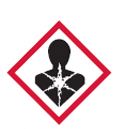
Honestly, I’m NOT too EXCITED about it. But, I’m trying to have a good attitude. Below are some good things which may occur:
- Raise the level of awareness of hazardous materials & their toxicity
- Train employees (hopefully, retrain) on how to handle chemicals
- More training = less citations. (?)Â OSHA’s top ten citations include #3 – hazard communication. Maybe people will actually do the training?! (my guess is that there will be more citations)
- Consistent information worldwide. Â All UN countries should have the same format. (this might take years)
- Proprietary information will be more visible on the SDS. In the new rules, manufacturers are required to list the % of their proprietary ingredients.
- Pictograms! They’re so cool. My favorite is the exploding person.
- Maybe this is my favorite?!: Manufacturers will have to look again at their products and classify them according to the physical & health criteria. Nowadays with more relevant information from worldwide occupational exposure limits, it might help make employers aware of the hazards.
- This might help OSHA enforce newer exposure limits (other than the 1978 AGCIH TLVs).
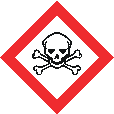
How do you plan on training your employees? If you need help, contact me here.
Thu 29 Nov 2012
Posted by admin under Admin Controls, Bio Exposure Index, Biological Monitoring, Engineering Controls, Hazard Communication, industrial hygienist, Lead, Leaded Sheetrock, OSHA, PEL (Perm Exp Limit), Personal Protective Equip (PPE), Respirators, Training
Comments Off on Construction Lead Paint – the basics
Looking back at my lead in construction posts, I realized I did an inadequate job of summarizing why construction activities are dangerous when working with lead.
If you work in construction, here’s are the quick points as to why you should be concerned about lead.
- There has been A LOT of lead added to paint over the years. (it can vary 0.01% to upwards of 20%, and there’s no way to tell by looking)
- The activities we do in construction disturb this paint (some worse than others)
- You can be exposed to paint by inhaling it (if it is airborne), and if you happen to get it on your hands and you eat it (by transfer).
- The real concern is kids. (your kids, the kids who might be there after you’re gone, AND, the kids unborn (lead exposure can go from mom to baby)
The solution is simple (and, of course, more complicated as you dig in):
- test the paint to see if there’s lead in it
- if you disturb it, follow the rules (OSHA, EPA, HUD, City, etc.)
- train your employees (and measure the lead in their blood)
- prevent the dust from going everywhere (containment)
- measure the air to see if you are really screwing it up, or doing a good job.
- finally clean up. (the area, you, your hands, the perimeter) and dispose properly
Mon 26 Nov 2012
You probably already knew this. Risk changes over time.
As we start to measure, and value, loss we immediately want to minimize it. However, it’s an unobtainable goal. “Zero losses”. Really? It’s not actually possible, you know (at least in the long term).
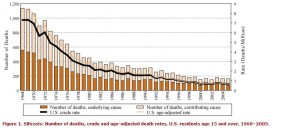 Look at this graph of the number of deaths in the US over the years due to silica. In 1968 we had approximately 1,000 deaths. Now, in the year 2005, we are less than 200. Yet, OSHA wants us to lower the exposure limit.  (I am personally not opposed to it – but I am open to debate about it, really)
Look at this graph of the number of deaths in the US over the years due to silica. In 1968 we had approximately 1,000 deaths. Now, in the year 2005, we are less than 200. Yet, OSHA wants us to lower the exposure limit.  (I am personally not opposed to it – but I am open to debate about it, really)
Our world is becoming smaller. But, you already knew this, too.
To give an example, look at what happened in Bangladesh on November 24/25, 2012. Meanwhile in the US, we were watching football and eating leftover turkey. Â Over 100 people died due to safety concerns that turned into a fire. This country is going through what the US experienced pre-1970. Other countries have similar problems.
I suppose living in the US is a yet another reason for thanksgiving. Yes…, But.  What can you do to make the biggest impact? I don’t have the answer, but, I am open to suggestions.
Wed 21 Nov 2012
Posted by admin under Asbestos, Carcinogen, EPA, Federal OSHA, Hazard Communication, OSHA, Training, Uncategorized
Comments Off on What is disturbance of asbestos?
When training people who work around asbestos I usually discuss the word “disturbance” for a LONG time. The reason is simple. If you avoid “disturbing” it, you avoid most of the health issues.
As most people are aware, asbestos is found in many types of materials. Floor tiles, popcorn ceilings, wall panels, etc.
Disturbance relates to the specific activities you perform AND the type of material the asbestos is in.
If the asbestos containing material (ACM) is non-friable, then in theory, it takes more effort to disturb the asbestos. If the material is friable, well, you need to be REALLY careful. – and in some cases, breathing can disturb it. For example, an electrician who uncovers an ancient acoustical ceiling panel and finds damaged asbestos pipe insulation laying on top of it…is probably already in trouble. He has essentially disturbed friable asbestos by merely moving the panel.
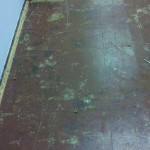 In contrast, a remodeling company installing a floating laminate hardwood over asbestos 9×9 inch tiles (without damaging them) is [probably*] NOT causing airborne releases of asbestos.
In contrast, a remodeling company installing a floating laminate hardwood over asbestos 9×9 inch tiles (without damaging them) is [probably*] NOT causing airborne releases of asbestos.
Most of the OSHA/EPA asbestos rules hinge on the matrix of the material and the activity you are performing on it. The reason is this is what makes the asbestos fiber airborne.
*the OSHA rules are very specific as to work activity, please do your due diligence.
Fri 16 Nov 2012
Posted by admin under Air Monitoring, Biological Monitoring, Dust, EPA, Federal OSHA, HEPA, Lead, OSHA, Personal Protective Equip (PPE), Respirators, Safety Programs, Training, Uncategorized
1 Comment
You must follow both. (I’ve mentioned this before)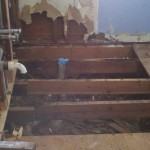
OSHA’s rules are very detailed and apply to any amount of lead in paint (even less than 0.5%) if you are disturbing it. The only time OSHA rules do not apply is:
- if you are working as a sole-proprietor (no employees), or
- if you are in some other country.
EPA’s rules are just a start. They apply to any residential facility where there are kids under the age of 6. OSHA’s rules are much more comprehensive and protective. (in some instances, overkill)
To EPA’s credit, they have done a great job of marketing and letting contractors know they insist on compliance. OSHA, on the other hand, only inspects 2% of businesses/year and does virtually no marketing. The chances of OSHA showing up on any given jobsite, is nearly 0%.
OSHA’s rules are very complete and comprehensive. You WILL need air monitoring, blood monitoring, PPE, change areas, water/sanitation, and training. The worst thing you can do is NOT follow the OSHA rules, find overexposures, and then try to “make up” for it. From my experience this scenario is a bad place to be, and happens all the time.
Fri 9 Nov 2012
People who work in industrial hygiene try NOT to admit fault. There are reasons;  legal implications, credibility, and of course, pride. Since this blog is about being transparent, I will confess I made a huge mistake. My mistake wasn’t disastrous, but it could have been.
Background:
Employees were using a hudson sprayer (pump style) to apply a liquid waterproofing material. Air monitoring was performed and found to be 50% of the OELs. However, given the environmental conditions, and different areas they would need to access, I recommended they wear 1/2 face respirators. The hazard was isopropyl alcohol and a 1/2 face respirator with organic vapor cartridges was sufficient, with goggles & protective clothing.
However. It wasn’t isopropyl alcohol….it was methyl alcohol (methanol). And, there is a HUGE difference. Organic vapor cartridges (filters) provide NO protection to methanol. I should have recommended supplied air respirators.
I feel terrible, and I apologized.
“Success does not consist in never making mistakes but in never making the same one a second time” – George Bernard Shaw







 In contrast, a remodeling company installing a floating laminate hardwood over asbestos 9×9 inch tiles (without damaging them) is [probably*] NOT causing airborne releases of asbestos.
In contrast, a remodeling company installing a floating laminate hardwood over asbestos 9×9 inch tiles (without damaging them) is [probably*] NOT causing airborne releases of asbestos.